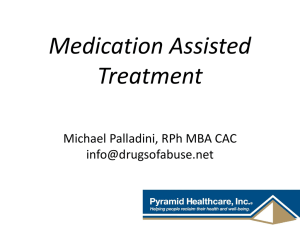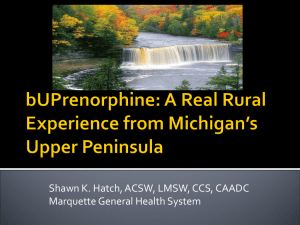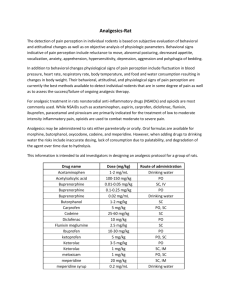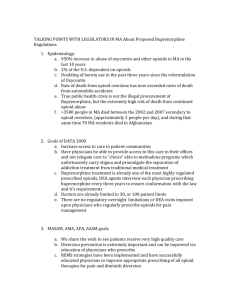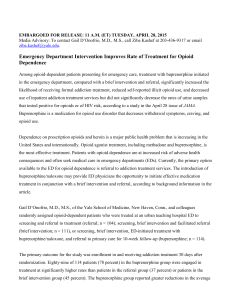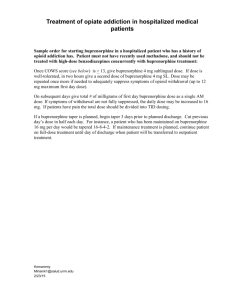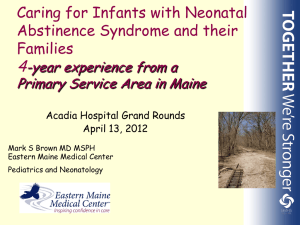Addiction for Two
advertisement
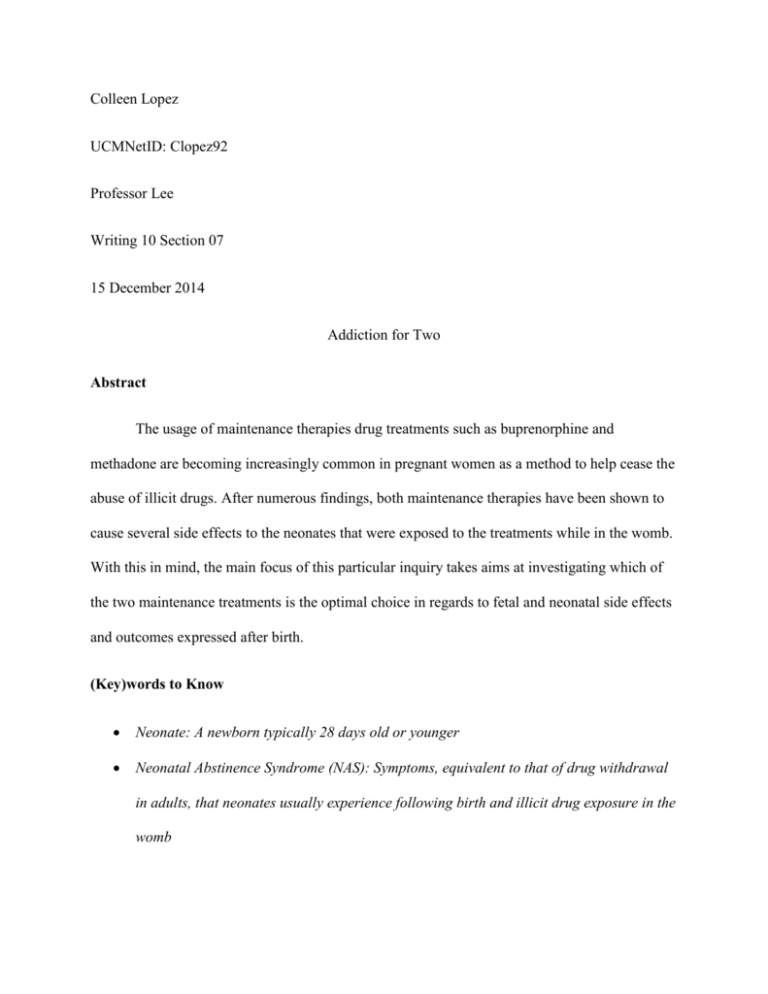
Colleen Lopez UCMNetID: Clopez92 Professor Lee Writing 10 Section 07 15 December 2014 Addiction for Two Abstract The usage of maintenance therapies drug treatments such as buprenorphine and methadone are becoming increasingly common in pregnant women as a method to help cease the abuse of illicit drugs. After numerous findings, both maintenance therapies have been shown to cause several side effects to the neonates that were exposed to the treatments while in the womb. With this in mind, the main focus of this particular inquiry takes aims at investigating which of the two maintenance treatments is the optimal choice in regards to fetal and neonatal side effects and outcomes expressed after birth. (Key)words to Know Neonate: A newborn typically 28 days old or younger Neonatal Abstinence Syndrome (NAS): Symptoms, equivalent to that of drug withdrawal in adults, that neonates usually experience following birth and illicit drug exposure in the womb ADDICTION FOR TWO (CLOPEZ92) 2 Sudden Infant Death Syndrome (SIDS): An unexplained death of a baby that is typically healthy. SIDS usually occurs in infants that are 1 month to 1 year old. Buprenorphine (BMT): A maintenance therapy drug that has been used to wing nonpregnant drug abusers off of illicit drug use since the 1990’s. This specific treatment has not been approved by the FDA for use in pregnant women. Methadone (MMT): A maintenance therapy drug that has been used since the 1970’s to taper individuals off of substance abuse. It is the only maintenance therapy drug recommended for use in pregnant women. Background Drug abuse is becoming an increasingly exacerbated problem throughout the world. As the problem continues to worsens, the amount of women, many of whom in their childbearing years, will ultimately become addicted to drug substances. In many of these cases, women who are pregnant do not experience their drug abuse alone. Fetuses can ultimately absorb the substance taken in by the mother via the umbilical cord and placenta, which could ultimately cause addiction to occur in fetuses after continuous and extraneous use much like it would in a fully developed adult. Despite the fetus becoming addicted to the mother’s substance abuse, there are numerous other health consequences that arise from a mother’s constant use of substances while pregnant which include: low birth weight, longer hospital stays, premature delivery, poor nutritional status, developmental delays, and increased risk of both SIDS and NAS. In the many cases, the addiction follows the baby after birth and then ultimately wreaks havoc on the baby’s comfort and health through the side effects brought on from withdrawal symptoms, otherwise known as Neonatal Abstinence Syndrome (NAS) which affects nearly half of newborns born to opioid-dependent mothers (Unger, Metz, &Fischer,2012). ADDICTION FOR TWO (CLOPEZ92) 3 In order to avoid such negative occurrences from befalling neonates and to slowly taper off the maternal parent’s drug abuse, expecting mothers undergo maintenance drug therapies which occur with the use of either methadone or buprenorphine. Methadone has been used as a maintenance therapy drug for substance abuse treatment since the 1970s and has been the recommended treatment for illicit drug abuse for some time. Its counterpart, buprenorphine, has been utilized for a short amount of time and has only been approved for use in the non-pregnant population since the 1990s. Despite several decades of public use of both treatments, research is still being conducted in order to fully understand the consequences that arise in the babies that are exposed to them in utero. Both treatments have been known to cease or hinder the NAS and other substance abuse symptoms that arise in premature birth or in the neonates after birth, however, there have been noted instances where both BMT and MMT have caused repercussions of various severities of their own. The treatments themselves have been known to cause NAS of fluctuating severity in neonates who were exposed to maternal drug use and maintenance therapy in utero. Despite this particular NAS result, there have also been cases where both treatments have caused numerous other side effects as well. Because little is known about both treatments, it is in fact probable that the treatments of buprenorphine or methadone therapies were in fact not in the best interest of the babies’ health, as much it would have been if the side effects of both therapies had been fully understood and detected. This particular paper revolves around three main objectives, one of which involves reviewing and examining numerous studies in order to determine the effects that both maintenance therapies have on newborn babies. After determining how both treatments affect babies, the focus will then shift to address which of the two therapies is the superior, or optimal, choice in regards to fetus and neonate health based off of the results uncovered during the first half of the paper. The lastly emphasis of the study will focus on ADDICTION FOR TWO (CLOPEZ92) 4 whether the treatments expose fetuses and neonates to possible pain and discomfort and health risks because many researchers are still trying to uncover all the potential benefits and side effects of both treatments. As previously mentioned, maternal drug use during pregnancy does in fact negatively affect and influence the health of fetuses in utero and neonates after birth by means of developmental delays, heart attacks, seizures, respiratory failures, strokes, birth defects, premature birth, low birth weight, behavioral problems, and other severe effects such as still birth. In order to cease or, at least, curb the symptoms that arise from illicit drug use, in which mother and baby both simultaneously experience, physicians prescribe either methadone or buprenorphine maintenance therapies to expecting mothers. In essence, both BMT and MMT can be expensive, however, with the Affordable Healthcare Act, both treatments in extent will be covered within many health insurance plans. This would increase the treatment opportunities for pregnant women addicted to illicit substances as the burden of paying for the treatments are lifted off their shoulders. It is estimated that the average methadone costs is $203.36 per month without insurance whereas buprenorphine costs an estimated $500 per month without health insurance and with the health insurance act, more pregnant substance addicted women will have the opportunity to seek treatment that could potentially be beneficial to both her and her child(ren). Results There have been numerous studies that have made it a main focus to determine which of the two maintenance treatments displayed worse consequences and drawbacks when compared to the counter treatment. Findings regarding this specific inquiry have definitely and greatly ADDICTION FOR TWO (CLOPEZ92) 5 varied between each study. Numerous side effects have been documented for both maintenance therapies throughout various studies. Most inquiries have suggested that both buprenorphine and methadone therapies have similar effects regarding birth weight and height measurements (Lacroix et al, 2011). Both outcomes tend to be benefitting because both treatments ultimately hinder negative consequences such as low birth weight (birth weight that is classified as being less than 2500 grams and premature birth is defined as a baby born before 37 weeks of gestation) which could ultimately affect the overall health and wellbeing of the neonate (Buckley, Razaghi, & Haber, 2013; Lacroix et al, 2011). In regards to malformation and deformities, there were virtually no differences between the two sets of participants exposed to both therapy drugs (Lacroix et al, 2011). Babies exposed to methadone in the womb, however, were more likely to suffer withdrawal symptoms, otherwise known as NAS, after birth. In one particular study, 62.5% of neonates experienced NAS after methadone exposure than compared to that of 41.2% of babies that experienced NAS after buprenorphine exposure. Those that experienced NAS after MMT exposure also tended to experience a much more severer form of the withdrawal symptoms than compared to newborns that experienced the symptoms after BMT exposure. In these cases, BMT exposure yielded less serve systems yet NAS systems still occurred (Lacroix et al, 2011; Kaltenbach et al, 2012). Possible Buprenorphine Side Effects Babies who have also experienced NAS with buprenorphine exposure required significantly less amounts of morphine in order to dulcify the irritability and suffering that comes along with substance withdrawal. Current studies have shown that buprenorphine might actually have several repercussions beyond the neonate stage of life and into the childhood stage. These ADDICTION FOR TWO (CLOPEZ92) 6 problems could include difficulties with hand and eye coordination, visual-spatial ability, organization, and planning capabilities (Sundelin-Wahlsten, & Sarman, 2013). Researchers have also noted that babies exposed to buprenorphine tended to have an overall larger head circumference when compared to methadone exposed babies (Welle-Strand et al, 2012). In one unfortunate study, two infants died as a result from SIDS. Researchers are uncertain whether BMT had any specific correlation with the deaths of the babies, however, they were also uncertain if BMT could be the igniter that led to other factors that could have caused the two infant deaths (Kahila, Saisto, Kivitie-Kallio, Haukkamma, & Halmesmӓki, 2007). Buprenorphine maintenance treatment has not been approved for use in expectant and breastfeeding mothers by the FDA. Currently, the FDA classifies buprenorphine maintenance therapy as a “Category C” drug therapy, which implies that there is little to no well-controlled studies that have been tested in the human population. A category C classification also means that there are potential risks that arise from this specific drug treatment and or cause side effects that can be worse than the maternal drug use that treatment therapy is meant to cease. With this at hand, little is in place in regards to a legislative manner when it comes to the use of buprenorphine maintenance therapy besides the fact that it currently not FDA approved which means mothers are exposing their babies to the treatment at their own risk. In the absence of sufficient data, the use of buprenorphine will likely not be approved by the FDA. Because of such circumstances, the use of buprenorphine therapy treatment is solely at the physician and patients’ risks and in such cases, the prescribing physician must weigh the consequences of BMT treatment to the cons that arise from continued drug use. Despite lack of approval, there have been several contrary effects on pregnancy after continuous drug use. With this in mind and with encouragement from buprenorphine clinical guidelines, physicians must take care and caution ADDICTION FOR TWO (CLOPEZ92) 7 when prescribing buprenorphine to pregnant women, however, neonates still face the chance of suffering from the side effects of the treatment after birth. In other words, the attending physician would potentially have to decide if the buprenorphine maintenance treatment poses too great a risk to the expecting mother and the unborn fetus all the while keeping the interest of the baby and mother’s health after birth occurs. If in fact doctors think BMT is not worth the risk, it would then be determined if the expectant mother should slowly curb the illicit drug use or be prescribed to methadone maintenance therapy treatment instead of being treated with a BMT treatment. Possible Methadone Side Effects Babies who do become dependent on methadone while in the womb might not experience NAS symptoms up until four weeks of birth because MMT can be stored in the metabolism for a prolonged amount of time (Caviston, 1987), however, when withdrawal occurs then babies can develop a wide array of symptoms. Besides the possible side effects from BMT treatments, there have been findings that have also suggested possible correlations between fetus exposure to methadone therapy and possible health related consequences to neonate and childhood development. Infants who were exposed to MMT tended to face more severe symptoms of distress such as: constant crying, irritability, hypertonic, poor reaction to visual stimuli, and less motor maturity than compared to those exposed to buprenorphine (Johnson, Jones, & Fischer, 2003; Soyka, 2013). Other effects include longer hospital stays and NAS treatment than compared to buprenorphine treatment counterpart drug treatment (Fischer et al, 2006). Methadone has also been noted to correlate with more occurrences of suppression of the motor activity (Jansson et al, 2010). ADDICTION FOR TWO (CLOPEZ92) 8 Potential Alternative In most cases, morphine will also be utilized along with a maintenance therapy to alleviate some of the symptoms that arise after birth. For example, MMT might be utilized to hinder the effects of the mother’s drug use, however, after birth a neonate might still experience NAS symptoms. This is where morphine comes into the equation. At this point, morphine can be used to mask the pain and discomfort that the neonate experiences following NAS symptoms. Mothers could also have the possibility of skipping the maintenance therapy entirely and utilizing morphine for the after effects that could occur after birth. However, there is still the possibility that mother’s substance abuse would still be able to induce negative effects. If in fact mothers choose this specific path, morphine might not also be the optimal route to take because it could ultimately cause negative correlations to the neural cells of the growing brains in the fetus or neonate (Unger, Metz, & Fischer, 2012). ◘◘ Regardless of the several repercussions that have been documented with buprenorphine maintenance use, many researchers have deemed buprenorphine safe enough to be used as a methadone maintenance treatment substitute; whereas some go as far to state that BMT displays equal side effects and benefits when compared to MMT therapy and use (Lacroix et al, 2011; Johnson, Jones, & Fischer, 2003). In fact the buprenorphine clinical guidelines state that BMT is sufficient enough to use in the pregnant population as long as a prescribing physician highly weighs the side effects that buprenorphine could cause to occur in a pregnant woman as the treatment slowly tapers off of illicit drug abuse. Despite semi-approval from the buprenorphine clinical guidelines, the FDA has yet to approve its use in expectant mothers and have so far ADDICTION FOR TWO (CLOPEZ92) 9 recommended only methadone maintenance therapy for expecting mothers (Johnson, Jones, & Fischer, 2003). After many other studies, there has also been many who have disapproved of the use of buprenorphine for fear that the side effects will greatly impact the neonates’ health (Sundelin Wahlsten & Sarman, 2013). In simple terms the results uncovered by researchers are not conclusive and in fact greatly vary from each other much to an extent that some results contradict or display opposite conclusions that others have come upon. Implications and Solutions Results regarding the benefits and side effects of both treatments are at odds as report findings tend to vary. This, however, may be the result of researcher bias as certain scholarly articles highly favor methadone treatment, whereas other articles favor the use of buprenorphine. This bias unfortunately can also influence the validity of the results from the numerous studies conducted on both the benefits and side effects of both buprenorphine and methadone treatments. However, there are not enough studies that have been conducted to ensure the validity of any of the results that researchers have since come across in past studies. This could as well explain the potential researcher bias that inhibits data and findings of the studies. In essence, several factors might be benefitting and significant when it comes to potential advancement and understanding of both of the maintenance therapy treatments used to impede withdrawal symptoms in fetuses and neonates. One factor includes further investigation and studies. As referenced, the findings in studies have greatly varied since the beginning of the overall investigation of both treatments’ side effects. In order to validate a specific perspective of current findings, more research needs to be conducted with more participants as results might face researcher bias which could ultimately hinder the results currently seen throughput the data collected. ADDICTION FOR TWO (CLOPEZ92) 10 Another implication that could help influence the decisions and ultimately the FDA’s approval or disapproval of buprenorphine therapy would revolve around studies in which the number of individuals per maintenance group is equally established between the two study groups. Numerous cases have overlooked this potential factor that could ultimately affect the FDA’s decision to recommend buprenorphine use in pregnant women. In one particular case, a study focused on a total of 135 pregnant women. Of the total women being observed during the study, 90 women had undergone buprenorphine therapy while the remaining 45 women of the study had participated in methadone maintenance therapy (Lacroix et al 2011). Although the sole focus of the Lacroix et al study was not to observe the effects the treatments had on the mothers but rather the neonates, this lack of a balanced portion of treatment recipients could alter or misrepresent the data being gathered throughout the study and thus affect the overall conclusions that can be drawn upon by others. With much more balance between the two treatment groups, the FDA will find it better to analyze the results seen from dozens of studies and either approve or reject the use of buprenorphine treatment in expecting mothers who ultimately need medical assistance to ward off substance abuse and the withdrawal effects that accompany the cessation of addiction. Regardless of the FDA’s ultimate decision regarding the future recommendation of BMT, it is significantly important for a balance of the control groups because physicians would be able to prescribe the therapy to expectant mothers without knowing all the effects of the treatments. This could potentially cause future suffering and health risks to the fetuses in the wombs and the neonates after birth. In essence, it is essential to uncover the risks that are posed to the babies that are exposed to such treatments and in order to do this, research needs to be conducted in a much more balanced and controlled manner. ADDICTION FOR TWO (CLOPEZ92) 11 Studies conducted on the focus on the benefits and side effects of BMT only and not comparing the two treatments to each other are highly required for further understanding of BMT treatment. Most studies aim at comparing the pros and cons of BMT to those of MMT, however, these comparison results are not the only essential data needed. Focusing solely on buprenorphine will allow researchers to uncover both the benefits and repercussions that arise from use of the treatment. In some respects, the studies that compare the two treatments together might house some sense of bias as the researchers might be intent about finding any slight difference between the two treatments. This could potentially explain why findings and conclusions constantly vary between different studies. If researchers instead turn away from the mindset of trying to uncover differences between the two treatments, then perhaps they could focus their studies on solely the aliments that arise in either buprenorphine or methadone exposure and thus further the understanding of the effects that both treatments might have on the newborn recipients. Besides focusing on a specific treatment, researchers could also cut back on the variables within their studies. There have been numerous studies that had too many variables. Some studies focused on the effects of both BMT and MMT all the while observing women whom were all addicted to different drugs. Instead of observing the effects in many drug addictions, researchers should instead focus on one particular drug per study. For example, researchers could focus on the effect that BMT has on mothers who were addicted to, say, heroin. Narrowing down the focus of the study and eliminating several variables might enable researchers to find much more conclusive evidence. If this approach is taken, researchers might find that BMT provides better outcomes to neonates whose mothers were addicted to heroin rather than neonates exposed ADDICTION FOR TWO (CLOPEZ92) 12 to MMT in the same circumstances which would thus explain why the conclusions greatly varied. Conclusion Many of studies tend to come to varying conclusions about the safety of exposing fetuses and neonates to buprenorphine therapy. Numerous conclusions tend to view buprenorphine therapy as a risk to the neonate population (Sundelin Wahlsten & Sarman, 2013). On the other hand, others have declared that based upon their studies and several other findings that BMT is a safe treatment that have occasionally provided similar results and side effects when compared to that of methadone therapy if BMT was given in appropriate dosages (Lacroix et al, 2011; Soyka, 2013). Other findings tend to suggest that buprenorphine is, in fact, the superior treatment when compared to MMT because it has displayed several instances where outcomes have been much more favorable in regards to neonatal growth parameters and withdrawal symptoms experienced when compared to the counter MMT treatment (Welle-Strand et al, 2012; Kahila, Saisto, KivitieKallio, Haukkamma, & Halmesmӓki, 2007). Regardless of the standing of superiority of BMT, some researchers suggest that the expectant mothers should have more of a say regarding which maintenance therapy would be benefiting to both her and the baby’s preferences and life circumstances (Jones et al, 2012). Nevertheless, the evidence displayed in all studies and the varying conclusions that all studies have drawn to signifies that there is a need for more wellcontrolled and well-designed study cases in order to come to better conclusive understandings of buprenorphine maintenance therapy’s effects and benefits in the fetus and neonate populations (Johnson, Jones, & Fischer, 2003). Despite uncertainty with regards to the efficiency and level of safeness to the health of neonates exposed to buprenorphine, more efficient research needs to be completed in order to fully understand the pros and cons of not only BMT, but MMT as well. ADDICTION FOR TWO (CLOPEZ92) 13 One might suggest that there is not any urgency with this specific matter and that physicians could simply switch one maintenance therapy to the other if the desired outcomes are not being displayed or risks are becoming too prevalent in a patient and her child. However, studies have shown that switching therapies midway throughout the treatment could be extremely detrimental to the fetus. Based on the evidence at hand, I strongly believe that I am not qualified to make judgment regarding use or superiority of either maintenance therapy treatment. I strongly believe that in order to gain a response from the FDA regarding BMT, there needs to be more definite conclusions because the wellbeing of both substance addicted expecting mothers and their children could rely strongly on either MMT or BMT for quitting addiction. In essence, mothers and babies in this specific situation face a double edged sword which includes either facing addiction head on or the curbing of addiction with a treatment that might ultimately cause serious side effects of its own. My Opinion: At the beginning of my research, I believed that both maintenance treatments were the ideal treatments for mothers and babies addicted to illicit drugs, however, as I continued with my research I quickly realized that little was known about the benefits and side effects that both treatments could have on the fetuses and babies exposed to such treatments in the womb. In most cases, doctors must simply weigh the benefits and cons of the treatment to that of the potential outcomes the baby might experience if the treatments are not administered. In most respects to me, I believe that this could be potentially dangerous to the baby’s health if the proposed circumstances do not pan out exactly as the prescribing physician had thought. My overall ADDICTION FOR TWO (CLOPEZ92) 14 opinion towards both treatments have since changed following my research and I believe that both treatments have the potential to safely and effectively treat addiction in both mother and child if more is known about the effects that both could have on both treatment recipients because in essence, babies along with their mothers are fully capable, and do in most cases, experience drug withdrawal and discomfort, health repercussions, and in some unfortunate cases, death from drug abuse which is why this particular area of research and study is significantly important. In regards to the treatments themselves, the guess and check manner in which doctors prescribe the treatments might raise concerns in an ethical manner because the treatments could also cause serve side effects to the newborns as well and until the extent of the side effects are known, the treatments should not be fully utilized in pregnant women because in some cases, the treatments can end up causing the similar side effects that they are ultimately intended to stop. ADDICTION FOR TWO (CLOPEZ92) 15 Reference List Buckley, V., Razaghi, A., & Haber, P. (2013). Predictors of neonatal outcomes amongst a methadone and/or heroin-dependent population referred to a multidisciplinary perinatal and family drug health service. Australian & New Zealand Journal Of Obstetrics & Gynaecology, 53, 464-470. doi:10.1111/ajo.12080 Caviston, P. (1987). Pregnancy and opiate addiction. British Medical Journal (Clinical Research Edition), 295(6593), 285. Dashe, J. S., Sheffield, J. S., Olscher, D. A., Todd, S. J., Jackson, G. L., & Wendel Jr, G. D. (2002). Relationship between maternal methadone dosage and neonatal withdrawal. Obstetrics & Gynecology, 100(6), 1244-1249. Domenici, C., Cuttano, A., Nardini, V., Varese, L., Ghirri, P., & Boldrini, A. (2009). Drug addiction during pregnancy: Correlations between the placental health and the newborn's outcome – Elaboration of a predictive score. Gynecological Endocrinology, 25(12), 786792. doi:10.3109/09513590902898221 Fischer, G., Ortner, R., Rohrmeister, K., Jagsch, R., Baewert, A., Langer, M., & Aschauer, H. (2006). Methadone versus buprenorphine in pregnant addicts: a double-blind, doubledummy comparison study. Addiction, 101(2), 275-281. doi:10.1111/j.13600443.2006.01321.x Jansson, L. M., DiPietro, J. A., Velez, M., Elko, A., Williams, E., Milio, L., & ... Jones, H. E. (2011). Fetal neurobehavioral effects of exposure to methadone or buprenorphine. Neurotoxicology & Teratology, 33(2), 240-243. doi:10.1016/j.ntt.2010.09.003 ADDICTION FOR TWO (CLOPEZ92) 16 Johnson, R. E., Jones, H. E., & Fischer, G. (2003). Use of buprenorphine in pregnancy: patient management and effects on the neonate. Drug & Alcohol Dependence, 70S87. doi:10.1016/S0376-8716(03)00062-0 Jones, H. E., Heil, S. H., Baewert, A., Arria, A. M., Kaltenbach, K., Martin, P. R., & Fischer, G. (2012). Buprenorphine treatment of opioid-dependent pregnant women: a comprehensive review. Addiction, 5-27. doi:10.1111/j.1360-0443.2012.04035.x Kahila, H., Saisto, T., Kivitie-Kallio, S., Haukkamaa, M., & Halmesmäki, E. (2007). A prospective study on buprenorphine use during pregnancy: effects on maternal and neonatal outcome. Acta Obstetricia Et Gynecologica Scandinavica, 86(2), 185-190. doi:10.1080/00016340601110770 Kaltenbach, K., Holbrook, A. M., Coyle, M. G., Heil, S. H., Salisbury, A. L., Stine, S. M., & ... Jones, H. E. (2012). Predicting treatment for neonatal abstinence syndrome in infants born to women maintained on opioid agonist medication. Addiction, 45-52. doi:10.1111/j.1360Lacroix, I., Berrebi, A., Garipuy, D., Schmitt, L., Hammou, Y., Chaumerliac, C., & DamaseMichel, C. (2011). Buprenorphine versus methadone in pregnant opioid-dependent women: a prospective multicenter study. European Journal Of Clinical Pharmacology, 67(10), 1053-1059. doi:10.1007/s00228-011-1049-90443.2012.04038.x Soyka, M. (2013). Buprenorphine use in pregnant opioid users: a critical review. CNS Drugs, 27(8), 653-662. doi:10.1007/s40263-013-0072-z ADDICTION FOR TWO (CLOPEZ92) 17 Sundelin Wahlsten, V., & Sarman, I. (2013). Neurobehavioural development of preschool-age children born to addicted mothers given opiate maintenance treatment with buprenorphine during pregnancy. Acta Paediatrica, 102(5), 544-549. doi:10.1111/apa.12210 Unger, A., Metz, V., & Fischer, G. (2012). Opioid dependent and pregnant: what are the best options for mothers and neonates?. Obstetrics & Gynecology International, 1-6. doi:10.1155/2012/195954 Welle-Strand, G. K., Skurtveit, S., Jones, H. E., Waal, H., Bakstad, B., Bjarkø, L., & Ravndal, E. (2013). Neonatal outcomes following in utero exposure to methadone or buprenorphine: a national cohort study of opioid-agonist treatment of pregnant women in Norway from 1996 to 2009. Drug & Alcohol Dependence, 127(1-3), 200-206. doi:10.1016/j.drugalcdep.2012.07.001

